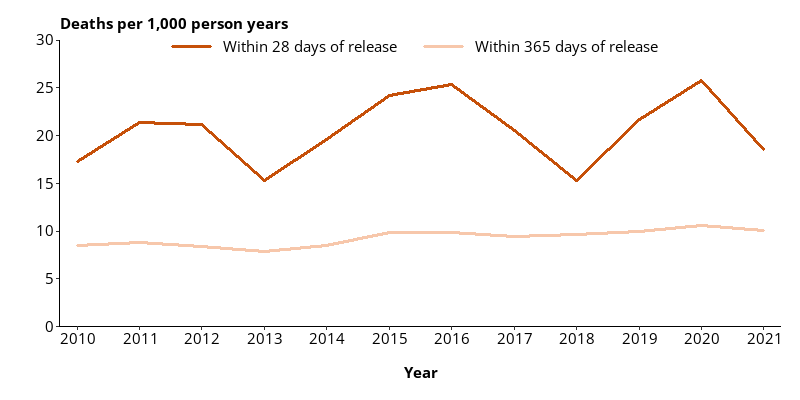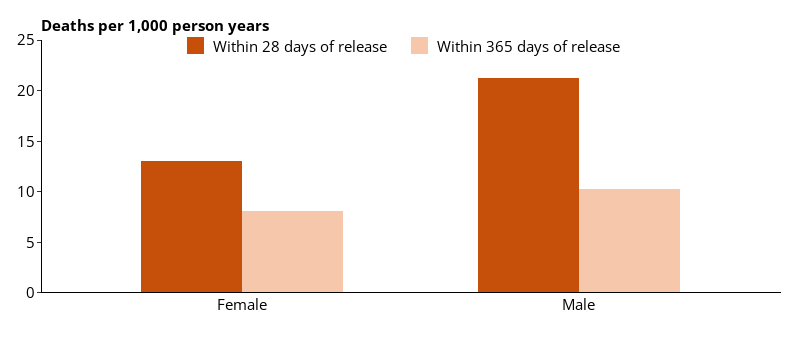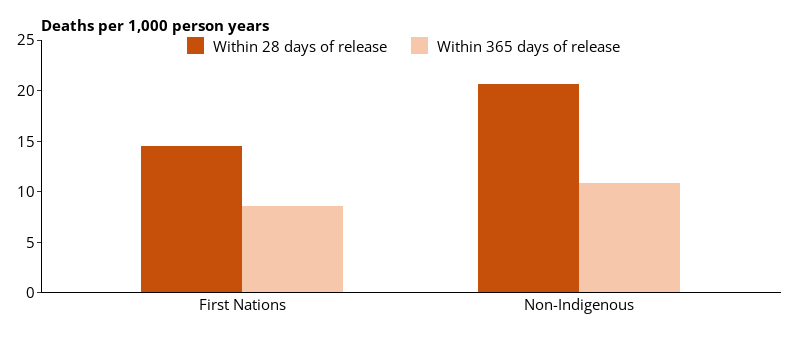Deaths following release from prison
People recently released from prison are at a higher risk of illness and death than the general population (Zlodre and Fazel 2012).
The risk of death is especially high in the first month after release, and the causes of death during this time are usually preventable – they include suicide, injury and overdose (Binswanger et al. 2007; Bukten et al. 2022; Forsyth et al. 2018; Kariminia et al. 2007; Stewart et al. 2004).
The risk of suicide among people recently released from prison is more than 6 times as high as that for the general population (Jones and Maynard 2013).
The risk of suicide for those recently released from prison is about 14 times as high for females, and about 5 times as high for males, as for females and males in the general population (Spittal et al. 2014).
Among people recently released from prison, rates of deaths from suicide are similar to rates of drug-related deaths (Spittal et al. 2014; van Dooren et al. 2013).
On release from prison, most people are eligible to apply for a crisis payment from Centrelink. In the 2022 NPHDC, more than a half (53%) of prison dischargees reported that they expected to receive a crisis payment from Centrelink.
People released from prison may also continue to receive payments from Centrelink in the form of income support. If a death occurs, it is usually recorded as the reason for cessation of Centrelink benefits in Department of Social Services data, which were used to estimate the number of deaths after release from prison. This is a validated method of estimating deaths following release from prison (Kinner and Forsyth 2016). However, because some individuals do not receive a crisis payment from Centrelink, and because not all people who die after release from custody are receiving Centrelink benefits at the time of death, this method may underestimate deaths.
Crude death rates for people released from prison were calculated as the number of deaths recorded in the Centrelink data divided by the total number of people recorded in the Centrelink data who had received the post-release crisis payment.
Since the 2018 NPHDC, people released from prison are counted once only, regardless of how many times they had been incarcerated over the previous month or year. This means that a single death is much less likely to be linked to multiple releases. As a result, the crude death rates have increased compared with those in previous calculations. As the method for death rate calculation has changed, current estimates in the NPHDC should not be compared with estimates before 2018.
Death rates were calculated for the first 28 days following prison release, and for the first year (365 days) following release.
Due to the relatively small numbers of the post-release prison population, and the small numbers of deaths within that population, the crude death rates vary from year to year (Figure 7.2).
In 2021, people released from prison were more likely to die within the first 28 days of release (18.5 per 1,000 person years) than within 365 days of release (10.1 per 1,000 person years) (Figure 7.2).
Figure 7.2: Trends in deaths within 28 days and 365 days of release from prison, per 1,000 person years, 2011–2021 (crude death rate)

Note: Calculations are based on the number of deaths released within the preceding 28 days or 365 days and the total number of people released.
Source: AIHW calculations of data supplied by the Department of Social Services 2023.
In 2021, the crude death rate for people within 28 days of release from prison was 1.4 deaths per 1,000 people released from prison. This equates to 18.5 deaths per 1,000 person years (Indicator 1.6.2).
In the same year, the crude death rate for people within 365 days of release from prison was 10.1 deaths per 1,000 people released from prison. This equates to 10.1 deaths per 1,000 person years (Indicator 1.6.3).
Males were 1.6 times as likely to die within 28 days of release (1.6 per 1,000 males released, or 21.2 per 1,000 person years) as females (1.0 per 1,000 females released, or 13.0 per 1,000 person years). Males were similarly as likely to die within 365 days of release (10.2 per 1,000 males released, or 10.2 per 1,000 person years) as females (8.0 per 1,000 females released, or 8.0 per 1,000 person years) (Figure 7.3).
Figure 7.3: Deaths within 28 days and 365 days of release from prison, per 1,000 person years, by sex, 2021 (crude death rate)

Note: Calculations are based on the number of deaths released within the preceding 28 days or 365 days and the total number of people released.
Source: AIHW calculations of data supplied by the Department of Social Services 2023.
Non-Indigenous Australians were more likely to die within 28 days of release (1.6 per 1,000 non-Indigenous people released, or 20.6 per 1,000 person years) than First Nations people (1.1 per 1,000 First Nations people released, or 14.5 per 1,000 person years).
Non‑Indigenous Australians were also more likely to die within 365 days of release (10.9 per 1,000 non-Indigenous people released, or 10.9 per 1,000 person years) than First Nations people (8.6 per 1,000 First Nations people released, or 8.6 per 1,000 person years) (Figure 7.4).
Figure 7.4: Deaths within 28 days and 365 days of release from prison, per 1,000 person years, by Indigenous identity, 2021 (crude death rate)

Note: Calculations are based on the number of deaths released within the preceding 28 days or 365 days and the total number of people released.
Source: AIHW calculations of data supplied by the Department of Social Services 2023.
People aged 55 and over were more likely than younger people to die, both within the first 28 days of release and within 365 days of release.
Binswanger IA, Stern MF, Deyo, RA, Heagerty PJ, Cheadle A, Elmore JG and Koepsell TD (2007) ‘Release from prison – a high risk of death for former inmates’, New England Journal of Medicine, 356(2):157–165, doi:10.1056/NEJMsa064115.
Bukten A, Skjærvø I and Stavseth MR (2022) ‘The association of prison security level with mortality after release from prison: a retrospective national cohort study (2000–16)’, The Lancet Public Health, 7(7):e583–e592, doi:10.1016/S2468-2667(22)00107-4.
Forsyth SJ, Carroll M, Lennox N and Kinner SA (2018) ‘Incidence and risk factors for mortality after release from prison in Australia: a prospective cohort study’, Addiction, 113(5):937–945, doi:10.1111/add.14106.
Jones D and Maynard A (2013) ‘Suicide in recently released prisoners – a systematic review’, Mental Health Practice, 17(3):20–27, doi:10.7748/mhp2013.11.17.3.20.e846.
Kariminia A, Law MG, Butler TG, Levy, MH, Corben SP, Kaldor JM and Grant L (2007) ‘Suicide risk among recently released prisoners in New South Wales, Australia’, Medical Journal of Australia, 187(7):387–390, doi:10.5694/j.1326-5377.2007.tb01307.x.
Kinner SA and Forsyth SJ (2016) ‘Development and validation of a national system for routine monitoring of mortality in people recently released from prison’, PLoS ONE, 11(6):e0157328, doi:10.1371/journal.pone.0157328.
Spittal MJ, Forsyth S, Pirkis J, Alati R and Kinner SA (2014) ‘Suicide in adults released from prison in Queensland, Australia: a cohort study’, Journal of Epidemiology & Community Health 68(10):993–998, doi:10.1136/jech-2014-204295.
Stewart LM, Henderson CJ, Hobbs MST, Ridout SC and Knuiman MW (2004) ‘Risk of death in prisoners after release from jail’, Australian and New Zealand Journal of Public Health, 28(1):32–37, doi:10.1111/j.1467-842X.2004.tb00629.x.
van Dooren K, Kinner SA and Forsyth S (2013) ‘Risk of death for young ex-prisoners in the year following release from adult prison’, Australian and New Zealand Journal of Public Health 37(4):377–382, doi:10.1111/1753-6405.12087.
Zlodre J and Fazel S (2012) ‘All-cause and external mortality in released prisoners: systematic review and meta-analysis’, American Journal of Public Health, 102(12):e67–75, doi:10.2105/AJPH.2012.300764.


